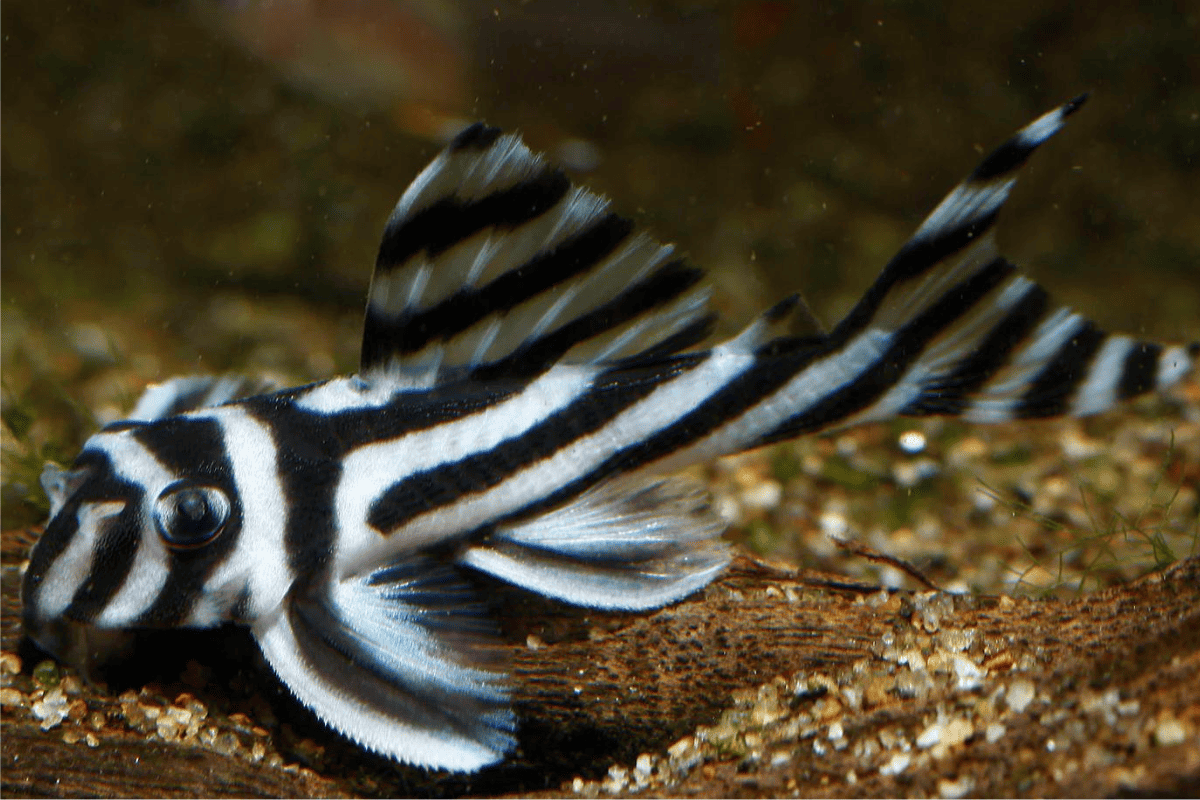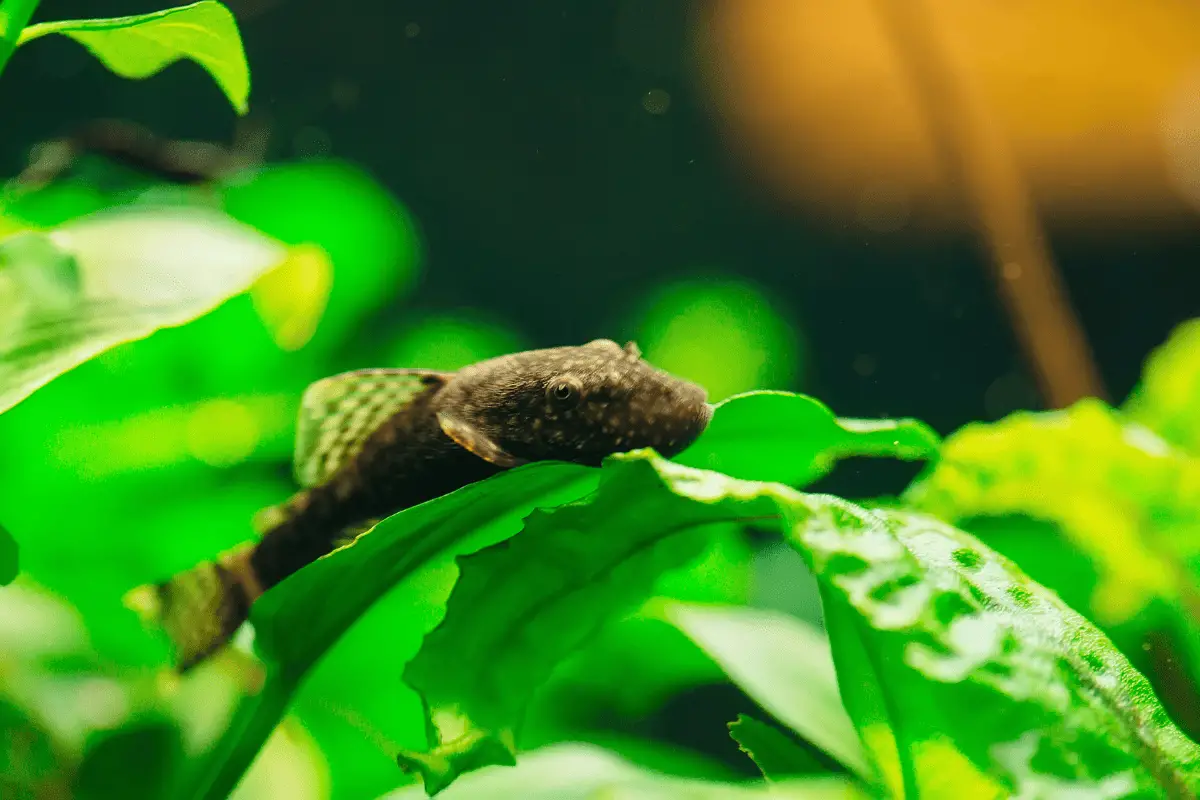Plecos are one of the most popular picks among aquarists, and for good reasons. They are incredibly beautiful and know how to clean algae efficiently.
But can they live in a tank as small as 5 gallons? Is this too small for them? What is the minimum tank size for different types of plecos?
And if not, what algae eaters can you keep in such a small tank?

Can I Have a Pleco in a 5-Gallon Tank?
No, you cannot keep a Pleco in a 5-gallon tank. Plecos require much larger spaces to thrive and grow properly.
- Size of Adult Plecos: Most common Plecos can grow up to 12 to 24 inches long. A 5-gallon tank does not offer adequate space for their growth.
- Water Quality: Plecos produce a significant amount of waste, which can quickly pollute a small tank. Larger volumes of water can dilute waste better, ensuring a healthier environment for the fish.
- Natural Behavior: In the wild, Plecos are used to navigating large stretches of water. A 5-gallon tank does not allow them to exhibit their natural behaviors, leading to stress.
- Decoration and Hiding Spots: Plecos need hiding spots like caves and wood to feel secure. In such a small tank, it’s challenging to provide these while maintaining enough open space for them to move.
- Tankmates: Plecos often co-exist with other fish species. A 5-gallon tank hardly leaves room for the Pleco alone, let alone any tankmates.
What’s the Minimum Tank Size for Plecos?
The minimum tank size for Plecos largely depends on the species, but for the common Plecostomus, a 55-gallon tank is often recommended as a starting point.
Some smaller species might be okay in a 30-gallon tank, but providing more space is always better.
- Species Variation: There are over 150 species of Plecos, and they vary greatly in size. While a bristlenose Pleco might max out at 6 inches, the common Pleco can reach up to 24 inches.
- Room to Grow: Plecos grow rapidly, especially when young. A tank that seems spacious at first might become cramped as the Pleco matures, affecting its health and well-being.
- Natural Habitat: Plecos originate from large rivers and streams. Replicating this environment means providing ample space for them to swim and explore, which smaller tanks can’t offer.
Also Read: Pleco Fish Tank Size

For a better understanding, here’s a concise table showing the minimum tank size for different types of plecos:
| Pleco Species | Minimum Tank Size |
| Clown Pleco | 20 gallons |
| Bristlenose Pleco | 30 gallons |
| Zebra Pleco | 30 gallons |
| Rubber Lip Pleco | 30 gallons |
| Peppermint Pleco | 40 gallons |
| Butterfly Pleco | 40 gallons |
| King Tiger Pleco | 50 gallons |
| Snowball Pleco | 55 gallons |
| Whiptail Pleco | 55 gallons |
| Candy Stripe Pleco | 55 gallons |
| Spotted Rafael Catfish | 55 gallons |
| Vampire Pleco | 70 gallons |
| Blue Phantom Pleco | 70 gallons |
| Green Phantom Pleco | 70 gallons |
| Rhino Pleco | 70 gallons |
| Galaxy Pleco | 100 gallons |
| Common Plecostomus | 100 gallons |
| Royal Pleco | 125 gallons |
| Sunshine Pleco | 125 gallons |

How to Calculate the Right Tank Size for a Pleco
To calculate the right tank size for a Pleco fish, consider the expected adult size of the fish and use the 1-inch-per-gallon rule as a basic guideline.
Remember, the actual tank size might need to be larger due to Plecos’ unique needs.
- Identify your Pleco species to determine its expected adult size, e.g., a common Plecostomus can grow up to 24 inches.
- Apply the 1-inch-per-gallon rule: a 24-inch Pleco would need a starting point of 24 gallons.
- Plecos are bulkier, so you might need more than the 1 gallon per inch; consider doubling the required volume: 24 inches x 2 = 48 gallons.
- Account for activity levels; more active Plecos might need an extra 10% space: 48 gallons x 1.10 = 52.8 gallons.
- For tank mates, calculate their adult size and add the equivalent gallons: if adding a 6-inch fish, add 6 gallons.
- Decorations like caves and driftwood take up space; consider adding an extra 10% of the volume: 52.8 gallons x 1.10 = 58.08 gallons.
- Given Plecos’ high waste production, opt for an additional 10-20% tank volume to manage waste: 58.08 gallons x 1.20 = 69.7 gallons. You can round this up to 70 gallons.
Also Read: Pleco Species In A 10-Gallon Tank
Four Pleco Species that Remain Small
When considering a 5-gallon tank, which is pretty small, it is worth discussing some plecos types that remain small and don’t grow like other types:
1. Parotocinclus Spilosoma

This Pleco species is a dwarf among the Plecostomus, often remaining quite small throughout its lifespan.
However, they are active and need more space than one might initially assume.
- Size: The Parotocinclus Spilosoma typically grows to about 1.5 to 2 inches, making it one of the smaller Pleco species.
- Tank Suitability: While it’s tempting to consider a 5-gallon tank due to its size, these Plecos benefit from more space. A 10-gallon tank or larger would be more suitable.
- Behavior: Being an active scavenger, they require ample space to explore, graze, and interact with their environment.
2. Parotocinclus Jumbo

While the name “Jumbo” might suggest otherwise, these fish are actually quite small. However, they do love a spacious environment to swim around in.
- Size: They typically max out at 2 inches, making them much smaller than many Pleco varieties.
- Tank Suitability: A 10-gallon tank is preferable, even though they could fit in a 5-gallon one. This ensures their comfort and happiness.
- Behavior: They’re avid foragers and benefit from having ample room to express this natural behavior.
3. Parotocinclus Britskii

This lesser-known species, Parotocinclus Britskii, offers a smaller alternative for fish enthusiasts.
- Size: In captivity, they tend to grow between 1.5 to 2 inches.
- Tank Suitability: Despite their compact size, they are best suited for a 10-gallon setup rather than a 5-gallon one.
- Behavior: They’re spirited and inquisitive, always on the move, searching for food. A bigger tank allows for this activity.
4. Parotocinclus Maculicauda

If you’re seeking a tinier Pleco option, consider the Parotocinclus Maculicauda.
- Size: They usually grow to around 2 inches, offering a compact choice for fish lovers.
- Tank Suitability: A 10-gallon tank is ideal, even though they’re small, to give them room for their natural activities.
- Behavior: Just like their relatives, they’re lively bottom-dwellers who enjoy having space to forage and explore.
Tips for Raising a Pleco in a 5-Gallon Tank
Housing a Pleco in a 5-gallon tank isn’t the general recommendation due to their size and habitat needs.
However, if you’re considering it, either as a temporary measure or with a particularly small species, follow these crucial guidelines:
- Choose a Small Species: Go for tinier Pleco species, like the Parotocinclus Spilosoma, which might fit better in confined spaces. But remember, even these might eventually outgrow a 5-gallon tank.
- Monitor Water Quality: Plecos can be messy. Regular water changes and quality checks are essential. A reliable filter and frequent water tests ensure optimal conditions.
- Provide Sufficient Hiding Places: Even in smaller tanks, Plecos need places to hide and feel safe. Use decorations like small caves or driftwood, but ensure there’s still enough room for the fish to move.
- Limit Tank Mates: A 5-gallon tank is already tight for a Pleco, so it’s best to limit or entirely avoid other tank mates to reduce stress and competition for resources.
- Be Prepared to Upgrade: Recognize that a 5-gallon tank is a very temporary solution. As your Pleco grows or if you notice signs of stress, be prepared to move it to a more spacious environment.

Can I Grow a Pleco with Other Fish in a 5-Gallon Tank?
No, growing a Pleco with other fish in a 5-gallon tank is not recommended due to the inherent limitations of such a small space and the needs of the fish.
- Space Limitations: Even smaller Pleco species require room to maneuver and grow; adding other fish to the mix exacerbates the spatial constraints, making the environment unsuitable for all.
- Water Quality Issues: Plecos are prolific waste producers. Combining them with other fish elevates the waste levels rapidly, compromising water quality and fish health.
- Behavioral Conflicts: In confined spaces, territorial disputes become frequent. Both Plecos and other fish may exhibit stress-induced behaviors, leading to potential aggression.
- Diverse Needs of Fish: Each fish species has unique habitat requirements. A 5-gallon tank restricts the ability to cater to each species’ needs, especially when a Pleco is part of the equation.
What Algae Eaters Can Live in 5 Gallons?
In a 5-gallon tank, while Plecos aren’t suitable due to their size and requirements, there are several other algae eaters that can thrive.
Small, efficient, and adaptable, these alternatives can help manage algae in confined spaces.
- Nerite Snails: These snails excel at eating algae. Though small, they boast beautifully patterned shells, striking a balance between usefulness and aesthetics.
- Amano Shrimp: Hailing from Japan, Amano shrimp are top-notch when it comes to consuming algae. At a max of 2 inches, they fit snugly in a 5-gallon tank.
- Dwarf Otocinclus: These petite catfish, smaller than their Pleco cousins, are adept at cleaning algae. Typically growing to 1.5 inches, they’re suited for more compact tanks.
- Cherry Shrimp: These tiny, vibrant shrimp are always on the hunt for algae. Their bright hues bring a pop of color to any aquarium.
- Ghost Shrimp: These see-through shrimp, fascinating to observe, are allies in the fight against algae. Their modest size and easy-going nature make them a good match for 5-gallon spaces.
- Malaysian Trumpet Snails: Beyond diving into the substrate to aerate it, these snails are also keen on algae. However, their rapid breeding means you’ll need to keep an eye on their numbers.
- Ramshorn Snails: With their iconic spiral shells, these snails are adept algae eaters. Their varied shades bring both flair and functionality to your setup.

Conclusions
If you’re short on time, here’s a brief summary:
- Typical Plecos can’t flourish in a 5-gallon tank due to their sheer size and love for roomier spaces.
- For familiar Plecos, like the Plecostomus, a starting point of 55 gallons ensures their happiness.
- To figure out the best tank size for Plecos, consider their adult size, how active they are, and their waste output.
- Smaller Pleco breeds, like the Parotocinclus Spilosoma and Parotocinclus Jumbo, might be okay in tinier tanks, but they still need ample room.
- In a 5-gallon tank, mixing Plecos with other fish isn’t recommended due to space constraints, water quality, and possible squabbles.
